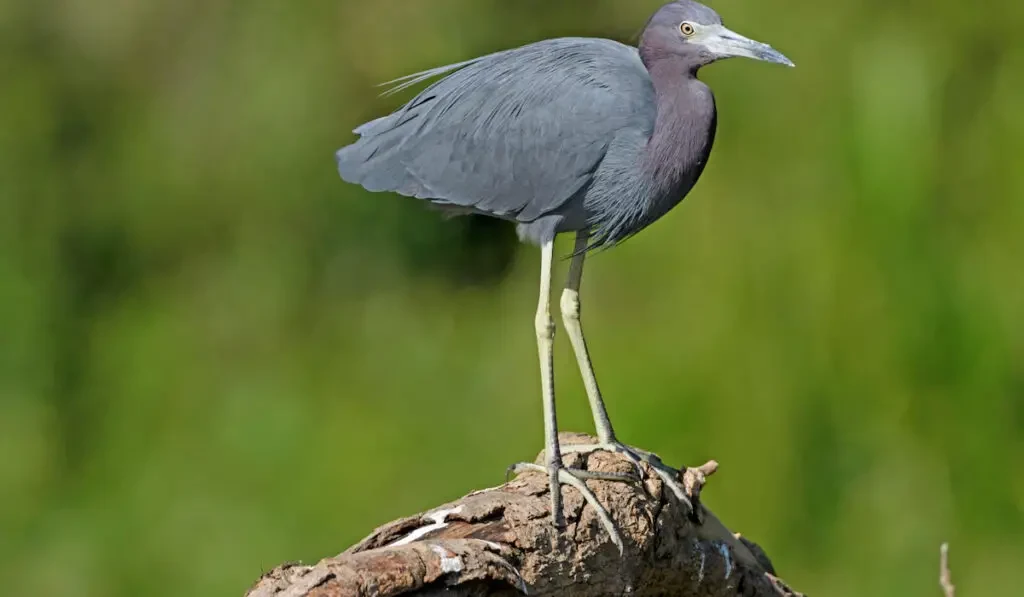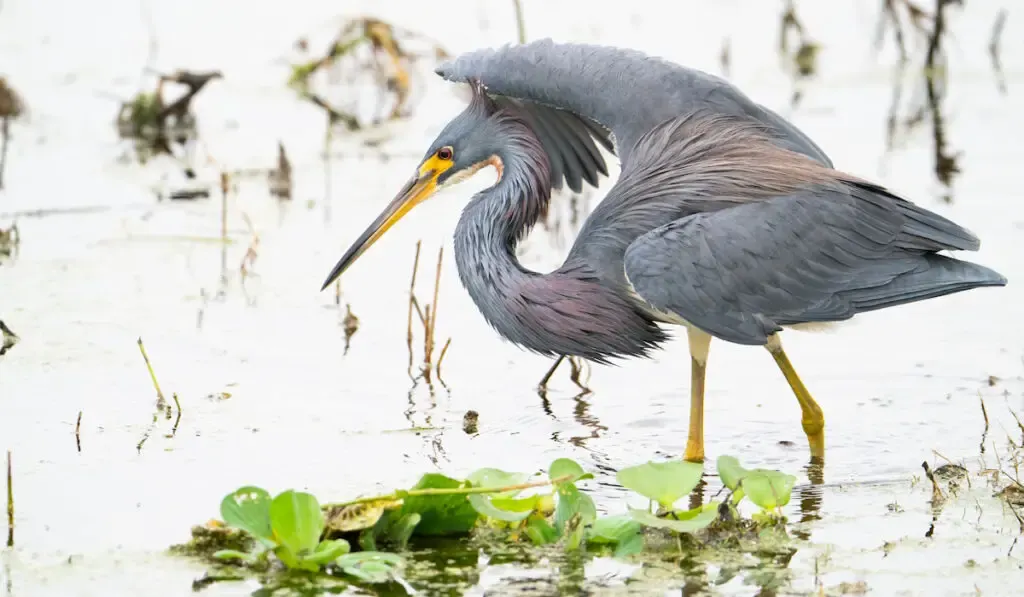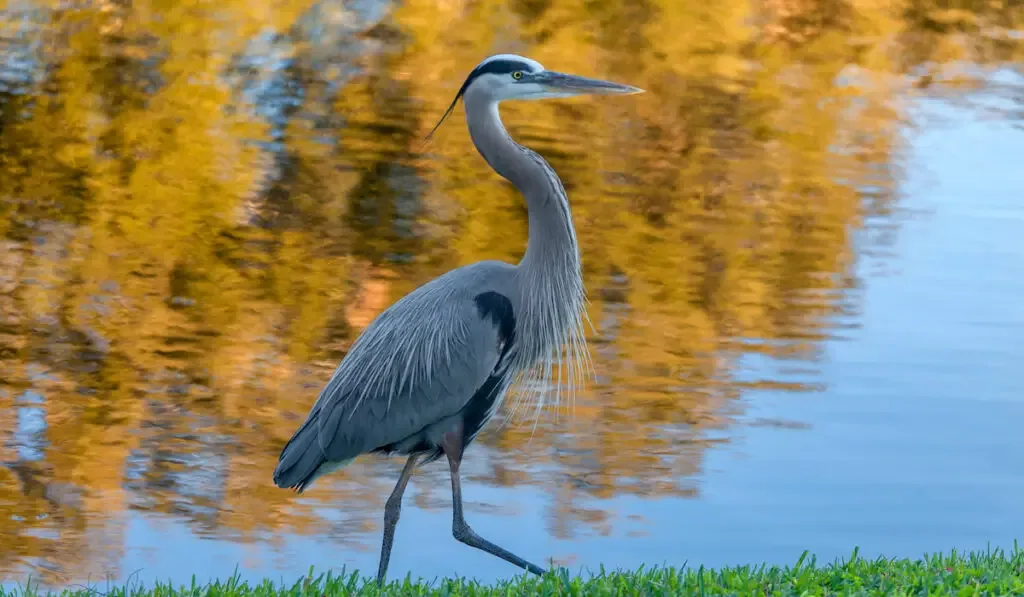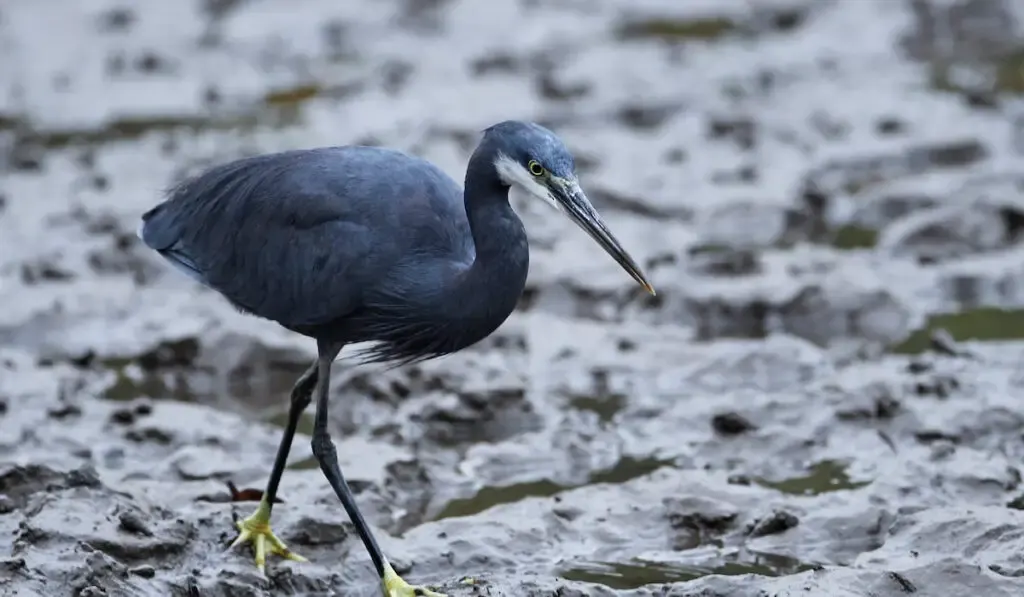If you have been wandering or taking a stroll around lakes, ponds, or forest wetlands, chances are, you have encountered long-legged birds that look similar to swans or flamingos. Although they look kind of similar, you can tell they are not one of those species.

These birds are called herons. Herons belong in the family Ardeidae and some of the smaller ones are known as bitterns and egrets.
It is estimated that there are around 60 species of herons in the world. They can be found in many parts of the world including the United States. In this article, we will take a deep look at 11 types of herons found in North America.
Table of Contents
1. Great Blue Heron

These are the largest herons in North America, great blue herons stand tall around 4.3 feet with an average wingspan of 82.7 inches. These long-legged birds inhabit wetlands, lakes, ponds, and saltwater in regions like North Carolina, Michigan, southern Florida, and all the way to Alaska.
Great blue herons are distinguished by their grayish-blue bodies, long neck and legs, with long and slender orange bills. They also have long black plumes and crowns on their head.
These herons will forage on shallow water by standing still or walking slowly before catching their food. They typically feed on fish, salamanders, frogs, snakes, turtles, insects, rodents, and small birds.
Female herons of this species lay between 3 to 7 pale blue eggs before incubating them for 25 to 30 days.
2. Black-Crowned Night Heron
Black-crowned night herons inhabit aquatic areas like saltwater, marshes, lakes, ponds, rivers, tidal swamps, and canals. They can be found across North America in regions like Michigan, the southern part of the United States, all the way to Mexico and Caribbean Islands.
These herons measure between 23 to 28 inches tall with an average wingspan of 4 feet.
Black-crowned night herons can be recognized by their stocky bodies, black cap, dark-blue back, whitish-gray wings, and pale gray bellies.
They also have yellow eyes and dark bills. These birds are most active at night or at dusk and feed on a variety of foods like fish, crustaceans, squids, mussels, clams, rodents, and occasionally eggs and small birds.
Female night herons lay between 3 to 7 pale blue-green eggs before incubating them for 21 to 26 days.
3. Little Blue Heron

Little blue herons are small wading birds that can be found across North America, especially in Missouri, Florida, east to Virginia, and west to Texas.
They also exist outside the United States in places such as Cuba, the coasts of Mexico and Central America, and in central South America. These birds inhabit aquatic regions like wetlands, marshes, lakes, ponds, swamps, and rivers.
Little blue herons have a purple-maroon head, dark blue bodies, and gray dagger-shaped bills with dark tips. These birds measure around 29 inches in length with an average wingspan of 41 inches.
They forage in shallow water by moving slowly before catching their prey. Their diet consists of different foods like fish, crustaceans, frogs, shrimps, and insects.
Female herons of this species can lay between 3 to 7 pale blue eggs before incubating them for 20 to 23 days.
4. Yellow-Crowned Night Heron
Yellow-crowned night herons typically inhabit coastal water, shallow tidal waters, lowland rivers, and open areas like wet lawns and golf courses.
In North America, they can be found in certain regions such as Pennsylvania, Long Island bays, Texas, Florida, and inlands in the Midwest.
These birds can be recognized by their black-and-white head, long yellow plumes, gray bodies, and yellow eyes. They measure around 24 inches in length with a wingspan of fewer than 4 feet.
Unlike other herons, yellow-crowned night herons have longer necks and legs with thicker bills. They are most active at night and mostly feed on crustaceans like crabs and crayfish. Occasionally, they will also eat fish, mollusks, frogs, and insects.
Female herons lay between 4 to 8 pale blue-green eggs before incubating them for 21 to 25 days. They will nest in isolated places or in very small groups, away from other bigger colonies.
5. Bare-Throated Tiger Heron

This species of herons can only be found in certain regions of the United States, which is in southern Texas near the border of Mexico. They also exist in Central America and in the southern regions of Mexico.
Bare-throated tiger herons are easily recognized by their gray bodies, black crown and bills, yellow throat, and markings on their face with greenish legs.
They have a larger body size compared to other herons, which are around 28 to 32 inches. However, their legs are quite short, which makes them look stocky in appearance.
Tiger herons typically feed on fish, crustaceans, crabs, frogs, and insects. When foraging, they will stand in shallow water, waiting motionlessly for quite a long time before catching their prey.
Female tiger herons usually lay between 1 to 3 pale white eggs in nests that overhang or are built near the edge of the water.
6. Green Heron
Green herons typically inhabit wetlands like lakes, marshes, ponds, coastal areas, mangrove swamps, and woodland streams.
These small herons can be found in certain regions of the United States like Florida, Texas, in Mid-Michigan during the summer, and as far as southern Canada and northern South America.
Green herons have stocky bodies with deep green back and crown, chestnut neck and chest with dark dagger-shaped bills, and bright orange legs. They measure between 16.1 and 18.1 inches in length with an average wingspan of 25.2 to 26.8 inches.
These birds typically feed on fish, crustaceans, insects, rodents, and mollusks. When hunting for prey, they will use bait like insects, leaves, twigs, and feathers before diving deep to catch them.
Female green herons lay between 3 to 5 pale blue eggs before incubating them for 19 to 21 days.
7. Tricolored Heron

Tricolored herons are medium-sized migratory birds that can be found in certain regions in the United States such as in Louisiana, along southern California, and inlands in Kansas, northwest Texas, and Colorado. They also exist on the Atlantic and Gulf of Mexico coasts.
These birds measure between 9.84 and 11.81 inches in length with an average wingspan of 15 inches.
Tricolored herons can be characterized by their colorful bodies that consist of three colors; blue-gray, lavender, and white. They also have dagger-like bills, long necks, and long yellow legs. These herons forage on shallow water and wait patiently for their prey to come before grabbing them.
In some cases, they will also stir the calm water to attract curious prey. Their diet consists of many foods like fish, crustaceans, frogs, tadpoles, insects, as well as lizards and spiders.
Female tricolored herons typically lay between 3 to 7 pale blue-green eggs before incubating them for 21 to 25 days.
8. Gray Heron

Gray herons’ population isn’t restricted to just Eurasia, Africa, Greenland, and Australia. They are also found in the United States, especially in Michigan and Muskeget Islands, in the town of Nantucket, Massachusetts. These birds typically inhabit coastal waters, freshwater regions, tidal flats, estuaries, and lakes.
They measure between 35 to 38 inches in length with a wingspan of 70 to 76 inches.
Gray herons possess distinctive black and white plumage with black plumes on their crown, black stripes on their long white neck, yellow bills, and long yellowish legs.
When foraging for food, they are able to stand with their neck stretched out or down over their chest.
These birds feed on a variety of foods including fish, crustaceans, small rodents, amphibians, reptiles, mollusks, large insects, and small birds.
Female gray herons typically lay between 3 and 7 light blue-green eggs before incubating them for 25 to 26 days. Male herons will aggressively defend the nests and unhatched eggs until their young are born.
9. Western Reef Heron

In 1983, sightings of Western Reef herons in Nantucket Island in Massachusetts have sparked the attention of researchers and ornithologists when they found that these birds spent an entire summer in that region.
Other sightings also have occurred in the northeastern United States and southeastern Canada. Nowadays, these medium-sized birds typically inhabit coastal waters, sandy shorelines, mangrove swamps, estuaries, and lagoons.
Western reef herons can be recognized by their pale black to dark gray bodies with yellow dagger-like bills and light yellow legs. They measure between 21.7 and 25.6 inches in length with an average wingspan of 34 to 41 inches.
These herons forage in daylight along mudflats and shallow water, looking for fish, crustaceans, marine worms, mollusks, and aquatic insects.
Female herons of this species lay between 2 and 3 eggs. Both parents will guard the unhatched eggs and raised their young for 28 to 30 days.
10. Great White Heron

Also known as the great white egret, these large, long-necked wading birds inhabit shallow wetlands, coastal water, tidal mudflats, marshes, and ponds. In the United States, they can be found in South Florida and the Florida keys.
Great white herons have large white bodies with yellow dagger-like bills and dark legs. They typically stand around 3.3 feet tall with bodies that measure around 31 to 41 inches in length. Their average wingspan is around 52 to 67 inches.
These birds feed on a variety of foods like fish, small mammals, amphibians, small reptiles, and insects. They will stalk their prey slowly before spearing them with their long and sharp bills.
Female white herons lay up to 6 pale blue-green eggs before incubating them for 23 to 26 days. Before mating, the males will select their nesting areas and make nests from sticks that are lined with plant material.
11. American Bittern
American bitterns can be found in Tennessee during their migrating season before wintering in the Gulf Coasts of the United States, Florida, the Everglades, the Caribbean Islands, and certain regions in Central America.
These stocky, medium-sized herons inhabit shallow wetlands, freshwater marshes, and occasionally open areas of shallow water. They measure between 23 to 24 inches in length with a wingspan of 3 feet.
American bitterns possess distinctive brown bodies with chestnut-striped necks, dark brown backs, yellow eyes, long yellow bills, and legs. They are most active around dusk or dawn and feed on fish, frogs, tadpoles, crustaceans, crayfish, and small reptiles.
Female bitterns typically lay between 3 and 7 pale brown or olive buff eggs before incubating them for 24 to 28 days. Unlike other herons, only females are attentive and responsible for their young.
Final Thoughts
While some types of herons are easy to spot, there are also other species that need more than just a mere glance.
With this detailed explanation about each type of heron, the next time you’re out for some sightseeing or bird-watching, there should be no confusion when you encounter these long-legged birds in their natural habitats.
Resources
Great Blue Heron
- https://www.audubon.org/field-guide/bird/great-blue-heron
- https://ebird.org/species/grbher3
- https://www.allaboutbirds.org/guide/Great_Blue_Heron/id
Black-Crowned Night Heron
- https://nhpbs.org/natureworks/blackcrown.htm
- https://www.audubon.org/field-guide/bird/black-crowned-night-heron
- https://www.allaboutbirds.org/guide/Black-crowned_Night-Heron/overview
Little Blue Heron
- https://www.audubon.org/field-guide/bird/little-blue-heron
- https://www.heronconservation.org/herons-of-the-world/list-of-herons/little-blue-heron/
- https://www.allaboutbirds.org/guide/Little_Blue_Heron/id
Yellow-Crowned Night Heron
- https://www.allaboutbirds.org/guide/Yellow-crowned_Night-Heron/overview
- https://www.audubon.org/field-guide/bird/yellow-crowned-night-heron
- https://www.pgc.pa.gov/Wildlife/EndangeredandThreatened/Pages/Yellow-CrownedNight-Heron.aspx
Bare-Throated Tiger Heron
- https://ebird.org/species/btther1
- https://www.birds-of-north-america.net/Bare-throated_Tiger-Heron.html
- https://www.sdakotabirds.com/species/bare_throated_tiger_heron_info.htm
Green Heron
- https://houstonaudubon.org/birding/gallery/green-heron.html
- https://www.allaboutbirds.org/guide/Green_Heron/lifehistory
- https://www.heronconservation.org/herons-of-the-world/list-of-herons/green-heron/
Tricolored Heron
- https://www.audubon.org/field-guide/bird/tricolored-heron
- https://animalia.bio/tricolored-heron
- https://www.allaboutbirds.org/guide/Tricolored_Heron/id
Gray Heron
- https://www.sdakotabirds.com/species/gray_heron_info.htm
- https://animaldiversity.org/accounts/Ardea_cinerea/
- https://www.nationalgeographic.com/animals/article/gray-heron-sighting-united-states-expanding-range
Western Reef Heron
- https://www.birds-of-north-america.net/Western_Reef-Heron.html
- https://www.sdakotabirds.com/species/western_reef_heron_info.htm
- https://ebird.org/species/werher
Great White Heron
- https://ebird.org/species/greegr
- https://www.fws.gov/refuge/Great_White_Heron/wildlife_and_habitat/greatwhiteheron/
- https://www.wildlifetrusts.org/wildlife-explorer/birds/herons-egrets-and-spoonbill/great-white-egret
American Bittern
